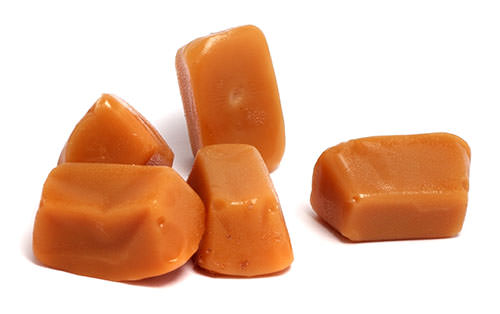The first thing you have to know about “chewy” and whiskey is the two don’t mix well if one of them is actually a wookiee. (Kidding, fellow nerds! That’s “Chewie,” and anyway he’s more of a wine spritzer man.)
But the word chewy is actually — in fact, quite often — used to describe certain characteristics of whiskey (and wine, but that’s another story). It’s a great descriptor; makes you think you’re about to bite into a boozy Snickers instead of taking a sip of bourbon. But what exactly is “chewy” whiskey? Does the term accurately describe a sensation, or is it just a funny term whiskey drinkers like to toss around after they’ve tossed one too many whiskies back?
Before we get into what it means, a disclaimer: chewy is not an “exact” descriptor, since taste will always be conceptually subjective, blah, blah, blah. But no, it’s fair — and important — to say that while certain concepts apply (e.g., caramelly bourbon, spicy rye, salty, smoky Islay Scotch), they’re all still based on individual perception.
It’s kind of like music: you might say a certain song is both funky and fresh, and while I acknowledge the freshness, I just don’t get a sense of the funk. But our opinions on the last Jazzy Jeff album do tend to generally collide. And thank God, because I can’t have that fight again.
Where things get interesting, with chewy, or any descriptor, is how people drill down from the broad stroke concept into sometimes improbably specific characteristics. Within the “smoky” character of a peated Scotch whiskey you might find someone suggesting campfire, somebody else noting a burning petrol smell, and someone else saying it smells like candle smoke from the birthday party nobody showed up to when they were in 7th grade.
Chewy has similar drill-down divides, but the broad strokes concept is pretty simple. It’s about the body of the whiskey and your perception of that body on your tongue. (No whiskey can smell “chewy,” though certain aromatics might give you a hint that chewiness is about to hit your palate.) What we’re really talking about when we say a whiskey is chewy is the mouthfeel. (As for “mouthfeel,” just imagine taking a sip of water and then a sip of heavily oaked Chardonnay; the wine will have a thicker mouthfeel unless your water’s gone real, real bad.)

Basically, chewiness is a kind of whiskey texture, almost always associated with a thicker mouthfeel and generally associated with certain flavors, which, incidentally, have some affinity to delicious candy bars. Think toffee, chocolate, fudge, nuttiness, caramel, dried fruit. Some drinkers associate it with a whiskey’s ability to coat the palate heavily, so you almost physically want to chew it. Some find chewiness not just in mouthfeel but in accompanying complexity of flavor (buttery Chardonnay has a thick mouthfeel but isn’t really described as chewy). That’s where notes of toffee and caramel and dark fruit and smoke and spice come in. A lot for your palate to work with, as if some kind of metaphorical mastication could do the job.
Again, since taste is subjective and blah blah blah, we thought a good way of showing you how and where people perceive chewiness would be to, well, show you where people perceive chewiness. We grabbed a handful of reviews for everything from smoky peated Scotch to Tennessee whiskey to Kentucky bourbon to a hopped (yep) whiskey, in which tasters had found notes of chewiness. Pay attention to how they describe chewiness and what they associate with it. See if there are any commonalities. And then go get yourself some whiskey, because learning about whiskey just by reading is about as gratifying as listening to a lecture about chocolate cake.
9-Year Single Cask Caol Ila Scotch Whisky
“Oily, ooey, chewy, mouth coating goodness.”
Glenfiddich 15 Year Single Malt Scotch Whisky
“As the whisky opens up, chewy toffee becomes apparent, transforming into the smell of overnight French toast…The substantial, chewy nature of the whisky pairs well with the butter and honey that stretch across the palate. Lastly, fig rounds the experience.”
Wild Turkey Rare Breed
“The palate resonates all the nice intricacies of sweet, savory, and spice from the nose but also comes with a remarkable chewy mouthfeel. It’s rich, sweet, and has a soft spice tint.”
George Dickel No. 12 Tennessee Whiskey
“Back palate fills up with lots of soft/chewy sticky [twiggy] timbers.”
Westland Sherry Wood American Single Malt Whiskey
“Here the nose is overwhelmed by burnt sugar and toffee notes, plus a touch of scorched citrus. On the tongue, it’s surprisingly malty, almost chewy, with notes of graham cracker plus a mushroomy character on the back end.”
Corsair Rasputin Hopped Whiskey
“Corsair Rasputin is an incredible whiskey that’s rich, dense, chewy.”
Laphroaig 10-Year Single Malt and 10-Year Cask Strength
“Taste-wise, there’s an initial wave of iodine and BBQ smoke, toasted barley, vanilla, and chewy toffee candy … This rich, almost chewy whisky leaves behind a smoky film covering your mouth and throat.”

